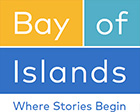A day trip to Urupukapuka Island is a chance to stretch your legs but also see and hear some of our weird and wonderful native birds, which are thriving there without mammalian predators.
You might come across the Dr Seuss-like nests of a pied shag colony, hear the revving call of a tieke (saddleback), or sit still while a toutouwai (North Island robin) hops around your boots.
Some areas of the island are better than others for seeing certain birds, so we talked to Project Island Song coordinator Richard Robbins, to get the low-down on birdwatching on the Bay of Islands’ largest island.
1. Land at Otehei Bay
The ferry will dock at Otehei Bay, which has a great café, grassy picnic area and safe swimming beach. Here you might see the variable oystercatcher scurrying along the sand, with its oversized red beak probing for food, and its piping call. You might also see the endangered New Zealand Dotterel, which tends to nest on the western end of the beach (keep your distance during breeding season to keep the chicks safe).
2. Otehei Bay Loop
This is the first track you come to after setting foot on the island. As you climb the hill, you might hear the melodies of the tui, especially if any of the trees or shrubs are flowering. This loop is kept largely as open grassland rather than forest (currently sheep do the mowing), because the land here is a site of high archaeological significance, but this does make for beautiful unobstructed views. Here you might also see New Zealand pipit hopping about flicking its tail, piwakawaka (fantail) whirling around for bugs, and kotare (New Zealand kingfisher) perched up high.
3. Paradise Bay Loop
This is a steep track with the most amazing views. Once you come down the track towards the coast, you will come to an area where forest birds have been released, so you’re likely to see noisy tieke, the friendly toutouwai (New Zealand robin), and the busy popokatea (whitehead), especially near the stream as you approach Oneura Bay. If you can’t see any birds, sit down and just wait quietly, soaking up the surroundings, and you may be rewarded with a fly-by. Further on in this loop you must look for the pied shag colony: the nests in the pohutukawa trees are collections of sticks which are very Dr Seuss-like. Although only active by night, wetapunga have also been released on this track.

4. Pateke Loop
This loop leads you to a large pond with a bird hide. Peeking out of the hide, you might see pateke (brown teal) swimming or dabbling away on the shore, eating bugs, seeds and plants. This is New Zealand’s rarest waterfowl, so it’s quite special to see it in the wild.
5. Cliff Pa Loop
On this loop you might see the incredibly cute miromiro (tomtit) foraging about the trees, and the raucous kakariki (red crowned parakeet). The kakariki were introduced to the nearby Moturua in 2017, and some have evidently flown themselves over to Urupukapuka.
6. Akeake Peninsula
This peninsula is of course a great place to see seabirds, for example the Australasian gannet, which can be seen plunging ferociously into the ocean to spear fish. The peninsula walk is quite open, so you might also see welcome swallows circling above, hear and see tui, and you might even see a banded rail (a rare wetland bird), which like the kakariki above, introduced itself to Urupukapuka all by itself.
Urupukapuka is an island of many habitats, with forests, bays, outcrops and wetlands, so it’s perfect for seeing a lot of different types of birds in one place – plus, it makes for a great day out walking in our beautiful Bay of Islands. For a map of the walking tracks and a list of the birds on the island check out the Project Island Song website and find out how to get there here.
